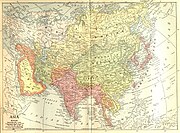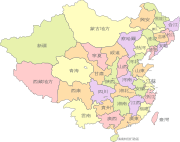
A | B | C | D | E | F | G | H | CH | I | J | K | L | M | N | O | P | Q | R | S | T | U | V | W | X | Y | Z | 0 | 1 | 2 | 3 | 4 | 5 | 6 | 7 | 8 | 9
Republic of China | |||||||||||||||||
|---|---|---|---|---|---|---|---|---|---|---|---|---|---|---|---|---|---|
| 1912–1949 | |||||||||||||||||
| |||||||||||||||||
| Anthem: Various
| |||||||||||||||||
| National seal: 中華民國之璽 "Seal of the Republic of China" (1929–1949)  | |||||||||||||||||
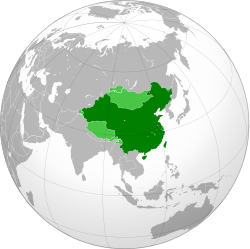 Land controlled by the Republic of China (1946) shown in dark green; land claimed but not controlled shown in light green.[a] | |||||||||||||||||
| Capital | |||||||||||||||||
| Largest city | Shanghai | ||||||||||||||||
| Official languages | Standard Chinese | ||||||||||||||||
| Recognised national languages | |||||||||||||||||
| Official script | |||||||||||||||||
| Religion | See Religion in China | ||||||||||||||||
| Demonym(s) | Chinese[1] | ||||||||||||||||
| Government | See Government of the Republic of China
Details
| ||||||||||||||||
| President | |||||||||||||||||
• 1912 | Sun Yat-sen (first, provisional) | ||||||||||||||||
• 1949–1950 | Li Zongren (acting) | ||||||||||||||||
| Premier | |||||||||||||||||
• 1912 | Tang Shaoyi (first) | ||||||||||||||||
• 1949 | He Yingqin | ||||||||||||||||
| Legislature | National Assembly | ||||||||||||||||
| Control Yuan | |||||||||||||||||
| Legislative Yuan | |||||||||||||||||
| History | |||||||||||||||||
| 10 October 1911 – 12 February 1912 | |||||||||||||||||
| 1 January 1912 | |||||||||||||||||
• Beiyang government in Beijing | 1912–1928 | ||||||||||||||||
• Admitted to the League of Nations | 10 January 1920 | ||||||||||||||||
| 1926–1928 | |||||||||||||||||
| 1927–1948 | |||||||||||||||||
| 1927–1936, 1945–1949 | |||||||||||||||||
| 7 July 1937–2 September 1945 | |||||||||||||||||
| 24 October 1945 | |||||||||||||||||
| 25 December 1947 | |||||||||||||||||
| 1 October 1949 | |||||||||||||||||
| 7 December 1949 [f] | |||||||||||||||||
| 1 May 1950[g] | |||||||||||||||||
| Area | |||||||||||||||||
| 1912 | 11,364,389 km2 (4,387,815 sq mi) | ||||||||||||||||
| 1946 | 9,665,354 km2 (3,731,814 sq mi) | ||||||||||||||||
| Currency |
| ||||||||||||||||
| Time zone | UTC+5:30 to +8:30 (Kunlun to Changbai Standard Times) | ||||||||||||||||
| Driving side | right[h] | ||||||||||||||||
| |||||||||||||||||
| History of the Republic of China |
|---|
 |
|
|
The Republic of China (ROC), or simply China, was a sovereign state based on mainland China from 1912 to 1949 prior to the government's relocation to Taiwan, where it continues to be based today.[f] The ROC was established on 1 January 1912 during the Xinhai Revolution against the Qing dynasty, ending the imperial history of China. The Republican government was ruled by the Kuomintang (KMT) as a one-party state based in Nanjing from 1927, until its flight to Taipei on 7 December 1949 following the KMT's de facto defeat by the Chinese Communist Party (CCP) in the Chinese Civil War. The CCP proclaimed the People's Republic of China on 1 October 1949, while the ROC retains control over the "Free Area", with the political status of Taiwan remaining in dispute to this day.
The ROC was formally declared on 1 January 1912, before Puyi, who had reigned as the Xuantong Emperor of the Qing dynasty, abdicated on 12 February 1912. Sun Yat-sen, the ROC's founder and provisional president, served only briefly before handing over the presidency to Yuan Shikai, the leader of the Beiyang Army. Yuan quickly became authoritarian and used his military power to control the administration, which consequently became known as the "Beiyang government". Yuan even attempted to replace the Republic with his own imperial dynasty until popular unrest forced him to back down. When Yuan died in 1916, the country fragmented between the various local commanders of the Beiyang Army. This began the Warlord Era defined by decentralized conflicts between rival cliques. The most powerful of these cliques, notably the Zhili and Fengtian cliques, at times used their control of Beijing to assert claims to govern the entire Republic.
Meanwhile, the nationalist KMT under Sun's leadership attempted multiple times to establish a rival national government in Guangzhou. Sun was finally able to take Guangzhou with the help of weapons, funding, and advisors from the Soviet Union. As a condition of Soviet support, the KMT formed the "First United Front" with the Chinese Communist Party. CCP members joined the KMT and the two parties cooperated to build a revolutionary base in Canton. Sun planned to use this base to launch a military campaign northwards and reunify the rest of China. Sun's death in 1925 precipitated a power struggle that eventually resulted in the rise of General Chiang Kai-shek to KMT chairmanship. Thanks to strategic alliances with warlords and help from Soviet military advisors, Chiang was able to lead a successful "Northern Expedition" from 1926 to 1928. By 1927, Chiang felt secure enough to end the alliance with the Soviet Union and purged the Communists from the KMT. In 1928, the last major independent warlord pledged allegiance to the KMT's Nationalist government in Nanjing.
While there was relative prosperity during the following ten years under Chiang Kai-shek, the ROC continued to be destabilized by the Chinese Civil War, revolts by the KMT's warlord allies, and steady territorial encroachments by Japan. Although heavily damaged by the purge, the CCP gradually rebuilt its strength by focusing on organizing peasants in the countryside. Warlords who resented Chiang's attempts to take away their autonomy and incorporate their military units into the National Revolutionary Army repeatedly led devastating uprisings, most significantly the Central Plains War. In 1931, the Japanese invaded Manchuria. They continued a series of smaller territorial encroachments until 1937, when they launched a full-scale invasion of China.
World War II devastated China, leading to enormous loss of life and material destruction. The war between China and Japan continued until the surrender of Japan at the end of World War II in 1945, which led to Taiwan being placed under Chinese administration. In the aftermath of World War II, civil war resumed between the areas liberated by the KMT and those liberated by the CCP. The CCP's People's Liberation Army managed to defeat the larger and better-armed National Revolutionary Army due to better military tactics and corruption of the ROC leadership. In 1949, the ROC repeatedly moved its capital to avoid the Communist advance—first to Guangzhou, followed by Chongqing, Chengdu, and lastly to Taipei. In October 1949, the CCP established the PRC. Remnants of the ROC government would hang on in mainland China until late 1951.
The ROC was a founding member of the League of Nations and later the United Nations (including its Security Council seat) where it maintained until 1971, when the PRC took over its membership in the United Nations General Assembly Resolution 2758. It was also a member of the Universal Postal Union and the International Olympic Committee. With a population of 541 million in 1949, it was the world's most populous country. Covering 11.4 million square kilometres (4.4 million square miles) of claimed territory,[2] it de jure consisted of 35 provinces, 1 special administrative region, 2 regions, 12 special municipalities, 14 leagues, and 4 special banners.
Name
The Republic of China's first president, Sun Yat-sen, chose Zhonghua Minguo (Chinese: 中華民國; lit. 'Chinese people's state') as the country's official Chinese name. The name was derived from the language of the Tongmenghui's 1905 party manifesto, which proclaimed that the four goals of the Chinese revolution were "to expel the Manchu rulers, revive China (Zhonghua), establish a republic (minguo), and distribute land equally among the people."[i] However, the conventional Chinese translation of republic was gongheguo (Chinese: 共和國; pinyin: Gònghéguó), not minguo (lit. "people's state").
On 20 October 1923, Sun said that Zhonghua Minguo means a state "of the people".[3] Both the "Beiyang government" (from 1912 to 1928), and the "Nationalist government" (from 1928 to 1949) used the name "Republic of China" as their official name.[4] In Chinese, the official name was often shortened to Zhongguo (Chinese: 中國; lit. 'middle country'), Minguo (Chinese: 民國; lit. 'peoples' country'), or Zhonghua (Chinese: 中華; lit. 'middle and beautiful').[5][6][7]
The country was in English known at the time as "the Republic of China" or simply "China".
In China today, the period from 1912 to 1949 is often called the "Republican Era" (simplified Chinese: 民国时期; traditional Chinese: 民國時期), because from the Chinese government's perspective the ROC ceased to exist in 1949.[8][9][10][11] In Taiwan, these years are called the "Mainland period" (大陸時期; 大陆时期), since it was when the ROC was based on the mainland.[12]
History
Overview
A republic was formally established on 1 January 1912 following the Xinhai Revolution, which itself began with the Wuchang uprising on 10 October 1911, successfully overthrowing the Qing dynasty and ending over two thousand years of imperial rule in China.[13] From its founding until 1949, the republic was based on mainland China. Central authority waxed and waned in response to warlordism (1915–1928), a Japanese invasion (1937–1945), and a full-scale civil war (1927–1949), with central authority strongest during the Nanjing Decade (1927–1937), when most of China came under the control of the authoritarian, one-party military dictatorship of the nationalist Kuomintang party (KMT).[14]
In 1945, at the end of World War II, the Empire of Japan surrendered control of Taiwan and its island groups to the Allies; and Taiwan was placed under the Republic of China's administrative control. The communist takeover of mainland China in 1949, after the Chinese Civil War, left the ruling Kuomintang with control over only Taiwan, Penghu, Kinmen, Matsu, and other minor islands. With the loss of the mainland, the ROC government retreated to Taiwan and the KMT declared Taipei the provisional capital.[15] Meanwhile, the CCP took over all of mainland China[16][17] and founded the People's Republic of China (PRC) in Beijing.
1912–1916: Founding

In 1912, after over two thousand years of dynastic rule, a republic was established to replace the monarchy.[13] The Qing dynasty that preceded the republic had experienced instability throughout the 19th century and suffered from both internal rebellion and foreign imperialism.[18] A program of institutional reform proved too little and too late. Only the lack of an alternative regime prolonged the monarchy's existence until 1912.[19][20]
The Chinese Republic grew out of the Wuchang Uprising against the Qing government, on 10 October 1911, which is now celebrated annually as the ROC's national day, also known as "Double Ten Day". Sun Yat-sen had been actively promoting revolution from his bases in exile.[21] He then returned and on 29 December, Sun Yat-sen was elected president by the Nanjing assembly,[22] which consisted of representatives from seventeen provinces. On 1 January 1912, he was officially inaugurated and pledged "to overthrow the despotic government led by the Manchu, consolidate the Republic of China and plan for the welfare of the people".[23] Sun's new government lacked military strength. As a compromise, he negotiated with Yuan Shikai the commander of the Beiyang Army, promising Yuan the presidency of the republic if he were to remove the Qing emperor by force. Yuan agreed to the deal.[24] On 12 February 1912, regent Empress Dowager Longyu signed the abdication decree on behalf of Puyi, ending several millennia of monarchical rule.[25] In 1913, elections were held for provincial assemblies, which would then chose delegates for a new National Assembly. The Kuomintang emerged as the formal political party that replaced the revolutionary organization Tongmenghui, and at the 1913 elections, it won the largest share of seats in both houses of the National Assembly and in some provincial assemblies.[26] Song Jiaoren led the Kuomintang Party to electoral victories by fashioning his party's program to appeal to the gentry, landowners, and merchants. Song was assassinated on 20 March 1913, at the behest of Yuan Shikai.[27]
Yuan was elected president of the ROC in 1913.[18][28] He ruled by military power and ignored the republican institutions established by his predecessor, threatening to execute Senate members who disagreed with his decisions. He soon dissolved the ruling Kuomintang (KMT) party, banned "secret organizations" (which implicitly included the KMT), and ignored the provisional constitution. Ultimately, Yuan declared himself Emperor of China in 1915.[29] The new ruler of China tried to increase centralization by abolishing the provincial system; however, this move angered the gentry along with the provincial governors, who were usually military men.
1916–1927: Warlord Era
Yuan's changes to government caused many provinces to declare independence and become warlord states. Increasingly unpopular and deserted by his supporters, Yuan abdicated in 1916 and died of natural causes shortly thereafter.[30][31] China then declined into a period of warlordism. Sun, having been forced into exile, returned to Guangdong in the south in 1917 and 1922, with the help of warlords, and set up successive rival governments to the Beiyang government in Beijing, having re-established the KMT in October 1919. Sun's dream was to unify China by launching an expedition against the north. However, he lacked the military support and funding to turn it into a reality.[32]
Meanwhile, the Beiyang government struggled to hold onto power, and an open and wide-ranging debate evolved regarding how China should confront the West. In 1919, a student protest against the government's weak response to the Treaty of Versailles, considered unfair by Chinese intellectuals, led to the May Fourth movement, whose demonstrations were against the danger of spreading Western influence replacing Chinese culture. It was in this intellectual climate that Marxist thought began to spread. The Chinese Communist Party (CCP) was founded in 1921.[33]
After Sun's death in March 1925, Chiang Kai-shek became the leader of the Kuomintang. In 1926, Chiang led the Northern Expedition with the intention of defeating the Beiyang warlords and unifying the country. Chiang received the help of the Soviet Union and the CCP. However, he soon dismissed his Soviet advisers, being convinced that they wanted to get rid of the KMT and take control.[34] Chiang decided to purge the Communists, massacring thousands in Shanghai. At the same time, other violent conflicts were taking place in China: in the South, where the CCP had superior numbers, Nationalist supporters were being massacred. Such events eventually led to the Chinese Civil War between the Nationalists and Communists.
1927–1937: Nanjing decade
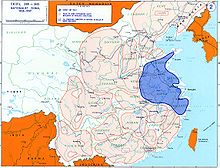
Chiang Kai-shek pushed the CCP into the interior and established a government, with Nanjing as its capital, in 1927.[35] By 1928, Chiang's army overthrew the Beiyang government and unified the entire nation, at least nominally, beginning the so-called Nanjing decade.[36]
Sun Yat-sen envisioned three phases for the KMT rebuilding of China – military rule and violent reunification; political tutelage; and finally a constitutional democracy.[37] In 1930, after seizing power and reunifying China by force, the "tutelage" phase started with the promulgation of a provisional constitution.[38] In an attempt to distant themselves from the Soviets, the Nationalist Government sought assistance from Germany.
According to Lloyd Eastman, Chiang Kai-shek was influenced by European fascist movements, and he launched the Blue shirts and the New Life Movement in imitation of them, in an effort to counter the growth of Mao's communism as well as resist both Western and Japanese imperialism.[39] According to Stanley Payne, however, Chiang's KMT was "normally classified as a multi-class populist or "nation-building" party but not a fitting candidate for fascism (except by old-line Communists)." He also stated that, "Lloyd Eastman has called the Blue Shirts, whose members admired European fascism and were influenced by it, a Chinese fascist organization. This is probably an exaggeration. The Blue Shirts certainly exhibited some of the characteristics of fascism, as did many nationalist organizations around the world, but it is not clear that the group possessed the full qualities of an intrinsic fascist movement....The Blue Shirts probably had some affinity with and for fascism, a common feature of nationalisms in crisis during the 1930s, but it is doubtful that they represented any clear-cut Asian variant of fascism."[40]
This article contains too many or overly lengthy quotations. (March 2024) |
Still other historians have noted that Chiang and the KMT's exact ideology itself was very complex and oscillated over time, with different factions of his government cooperating with both the Soviets and Germans as they saw fit, and that Chiang eventually became disillusioned with the Blue Shirts, which officially disbanded by 1938,[41][42] something Payne also mentions as "possibly because of competition with the KMT itself."[43] Some have also noted that in contrast to older historians from decades ago, Chiang's efforts have been increasingly seen by newer Western and Chinese historians alike as an arguably necessary if austere part of the complicated nation-building process in China during his time, especially given the wide range of both domestic and foreign challenges it faced on many different concurrent fronts.[44][45][46]
Several major government institutions were founded during this period, including the Academia Sinica and the Central Bank of China. In 1932, China sent its first team to the Olympic Games. Campaigns were mounted and laws passed to promote the rights of women. In the 1931 Civil Code, women were given equal inheritance rights, banned forced marriage and gave women the right to control their own money and initiate divorce.[47] No nationally unified women's movement could organize until China was unified under the Kuomintang Government in Nanjing in 1928; women's suffrage was finally included in the new Constitution of 1936, although the constitution was not implemented until 1947.[48] Addressing social problems, especially in remote villages, was aided by improved communications. The Rural Reconstruction Movement was one of many that took advantage of the new freedom to raise social consciousness.[citation needed] The Nationalist government published a draft constitution on 5 May 1936.[49]
Continual wars plagued the government. Those in the western border regions included the Kumul Rebellion, the Sino-Tibetan War, and the Soviet Invasion of Xinjiang. Large areas of China proper remained under the semi-autonomous rule of local warlords such as Feng Yuxiang and Yan Xishan, provincial military leaders, or warlord coalitions.[36] Nationalist rule was strongest in the eastern regions around the capital Nanjing. The Central Plains War in 1930, the Japanese invasion of Manchuria in 1931, and the Red Army's Long March in 1934 led to more power for the central government, but there continued to be foot-dragging and even outright defiance, as in the Fujian Rebellion of 1933–1934.[citation needed]
Reformers and critics pushed for democracy and human rights, but the task seemed difficult if not impossible. The nation was at war and divided between Communists and Nationalists. Corruption and lack of direction hindered reforms. Chiang told the State Council: "Our organization becomes worse and worse... many staff members just sit at their desks and gaze into space, others read newspapers and still others sleep."[50]
1937–1945: Second Sino-Japanese War
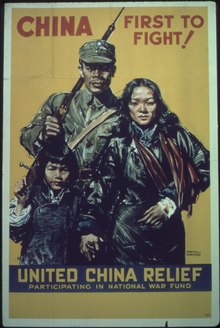
Few Chinese had any illusions about Japanese desires on China. Hungry for raw materials and pressed by a growing population, Japan initiated the seizure of Manchuria in September 1931, and established the former emperor Puyi as head of the puppet state of Manchukuo in 1932. The loss of Manchuria, and its potential for industrial development and war industries, was a blow to the Kuomintang economy. The League of Nations, established at the end of World War I, was unable to act in the face of Japanese defiance.
The Japanese began to push south of the Great Wall into northern China and the coastal provinces. Chinese fury against Japan was predictable, but anger was also directed against Chiang and the Nanjing government, which at the time was more preoccupied with anti-Communist extermination campaigns than with resisting the Japanese invaders. The importance of "internal unity before external danger" was forcefully brought home in December 1936, when Chiang Kai-shek was kidnapped by Zhang Xueliang and forced to ally with the Communists against the Japanese in the Second United Front, an event now known as the Xi'an Incident.
Chinese resistance stiffened after 7 July 1937, when a clash occurred between Chinese and Japanese troops outside Beijing near the Marco Polo Bridge. This skirmish led to open, although undeclared, warfare between China and Japan. Shanghai fell after a three-month battle during which Japan suffered extensive casualties in both its army and navy. Nanjing fell in December 1937, which was followed by mass murders and rapes known as the Nanjing Massacre. The national capital was briefly at Wuhan, then removed in an epic retreat to Chongqing, the seat of government until 1945. In 1940, the Japanese set up the collaborationist Wang Jingwei regime, with its capital in Nanjing, which proclaimed itself the legitimate "Republic of China" in opposition to Chiang Kai-shek's government, although its claims were significantly hampered due to its being a puppet state controlling limited amounts of territory.
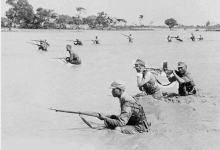
The United Front between the Kuomintang and the CCP had salutary effects for the beleaguered CCP, despite Japan's steady territorial gains in northern China, the coastal regions and the rich Yangtze River valley in central China. After 1940, conflicts between the Kuomintang and Communists became more frequent in the areas not under Japanese control. The Communists expanded their influence wherever opportunities presented themselves through mass organizations, administrative reforms and the land- and tax-reform measures favoring the peasants and, the spread of their organizational network, while the Kuomintang attempted to neutralize the spread of Communist influence. Meanwhile, northern China was infiltrated politically by Japanese politicians in Manchukuo using facilities such as the Manchukuo Imperial Palace.
After its entry into the Pacific War during World War II, the United States became increasingly involved in Chinese affairs. As an ally, it embarked in late 1941 on a program of massive military and financial aid to the hard-pressed Nationalist Government. In January 1943, both the United States and the United Kingdom led the way in revising their unequal treaties with China from the past.[51][52] Within a few months a new agreement was signed between the United States and the Republic of China for the stationing of American troops in China as part of the common war effort against Japan. The United States sought unsuccessfully to reconcile the rival Kuomintang and Communists, to make for a more effective anti-Japanese war effort. In December 1943, the Chinese Exclusion Acts of the 1880s, and subsequent laws, enacted by the United States Congress to restrict Chinese immigration into the United States were repealed. The wartime policy of the United States was meant to help China become a strong ally and a stabilizing force in postwar East Asia. During the war, China was one of the Big Four Allies, and later one of the Four Policemen, which was a precursor to China having a permanent seat on the United Nations Security Council.[53]
In August 1945, with American help, Nationalist troops moved to take the Japanese surrender in North China. The Soviet Union—encouraged to invade Manchuria to hasten the end of the war and allowed a Soviet sphere of influence there as agreed to at the Yalta Conference in February 1945—dismantled and removed more than half the industrial equipment left there by the Japanese. Although the Chinese had not been present at Yalta, they had been consulted and had agreed to have the Soviets enter the war, in the belief that the Soviet Union would deal only with the Kuomintang government. However, the Soviet presence in northeast China enabled the Communists to arm themselves with equipment surrendered by the withdrawing Japanese army.
1945–1949: Defeat in the Chinese Civil War
In 1945, after the end of the war, the Nationalist Government moved back to Nanjing. The Republic of China emerged from the war nominally a great military power but actually a nation economically prostrate and on the verge of all-out civil war. The problems of rehabilitating the formerly Japanese-occupied areas and of reconstructing the nation from the ravages of a protracted war were staggering. The economy deteriorated, sapped by the military demands of foreign war and internal strife, by spiraling inflation, and by Nationalist profiteering, speculation, and hoarding. Starvation came in the wake of the war, and millions were rendered homeless by floods and unsettled conditions in many parts of the country.
On 25 October 1945, following the surrender of Japan, the administration of Taiwan and Penghu Islands were handed over from Japan to China.[54] After the end of the war, United States Marines were used to hold Beijing and Tianjin against a possible Soviet incursion, and logistic support was given to Kuomintang forces in north and northeast China. To further this end, on 30 September 1945 the 1st Marine Division, charged with maintaining security in the areas of the Shandong Peninsula and the eastern Hebei, arrived in China.[55]
In January 1946, through the mediation of the United States, a military truce between the Kuomintang and the Communists was arranged, but battles soon resumed. Public opinion of the administrative incompetence of the Nationalist government was incited by the Communists during the nationwide student protest against the mishandling of the Shen Chong rape case in early 1947 and during another national protest against monetary reforms later that year. The United States—realizing that no American efforts short of large-scale armed intervention could stop the coming war—withdrew Gen. George Marshall's American mission. Thereafter, the Chinese Civil War became more widespread; battles raged not only for territories but also for the allegiance of sections of the population. The United States aided the Nationalists with massive economic loans and weapons but no combat support.
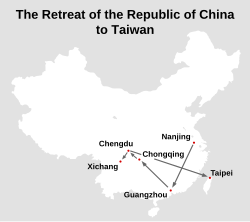
Belatedly, the Republic of China government sought to enlist popular support through internal reforms. However, the effort was in vain, because of rampant government corruption and the accompanying political and economic chaos. By late 1948 the Kuomintang position was bleak. The demoralized and undisciplined National Revolutionary Army proved to be no match for the Communists' motivated and disciplined People's Liberation Army. The Communists were well established in the north and northeast. Although the Kuomintang had an advantage in numbers of men and weapons, controlled a much larger territory and population than their adversaries, and enjoyed considerable international support, they were exhausted by the long war with Japan and in-fighting among various generals. They were also losing the propaganda war to the Communists, with a population weary of Kuomintang corruption and yearning for peace.
In January 1949, Beiping was taken by the Communists without a fight, and its name changed back to Beijing. Following the capture of Nanjing on 23 April, major cities passed from Kuomintang to Communist control with minimal resistance, through November. In most cases the surrounding countryside and small towns had come under Communist influence long before the cities. Finally, on 1 October 1949, Communists led by Mao Zedong founded the People's Republic of China. Chiang Kai-shek declared martial law in May 1949, whilst a few hundred thousand Nationalist troops and two million refugees, predominantly from the government and business community, fled from mainland China to Taiwan. There remained in China itself only isolated pockets of resistance. On 7 December 1949, Chiang proclaimed Taipei the temporary capital of the Republic of China.
During the Chinese Civil War both the Nationalists and Communists carried out mass atrocities, with millions of non-combatants killed by both sides.[56] Benjamin Valentino has estimated atrocities in the civil war resulted in the death of between 1.8 million and 3.5 million people between 1927 and 1949, including deaths from forced conscription and massacres.[57]
Government
The first Republic of China national government was established on 1 January 1912, in Nanjing, with a constitution stating Three Principles of the People, which state that " shall be a democratic republic of the people, to be governed by the people and for the people."[58]
Sun Yat-sen was the provisional president. Delegates from the provinces sent to confirm the government's authority formed the first parliament in 1913. The power of this government was limited, with generals controlling both the central and northern provinces of China, and short-lived. The number of acts passed by the government was few and included the formal abdication of the Qing dynasty and some economic initiatives. The parliament's authority soon became nominal: violations of the Constitution by Yuan were met with half-hearted motions of censure. Kuomintang members of parliament who gave up their membership in the KMT were offered 1,000 pounds. Yuan maintained power locally by sending generals to be provincial governors or by obtaining the allegiance of those already in power.
When Yuan died, the parliament of 1913 was reconvened to give legitimacy to a new government. However, the real power passed to military leaders, leading to the warlord period. The impotent government still had its use; when World War I began, several Western powers and Japan wanted China to declare war on Germany, to liquidate German holdings in China.
In February 1928, the Fourth Plenary Session of the 2nd Kuomintang National Congress, held in Nanjing, passed the Reorganization of the Nationalist Government Act. This act stipulated that the Nationalist Government was to be directed and regulated under the Central Executive Committee of the Kuomintang, with the Committee of the Nationalist Government being elected by the KMT Central Committee. Under the Nationalist Government were seven ministries—Interior, Foreign Affairs, Finance, Transport, Justice, Agriculture and Mines, and Commerce, in addition to institutions such as the Supreme Court, Control Yuan, and the General Academy.

With the promulgation of the Organic Law of the Nationalist Government in October 1928, the government was reorganized into five different branches, or yuan, namely the Executive Yuan, Legislative Yuan, Judicial Yuan, Examination Yuan as well as the Control Yuan. The Chairman of the National Government was to be the head-of-state and commander-in-chief of the National Revolutionary Army. Chiang Kai-shek was appointed as the first chairman, a position he would retain until 1931. The Organic Law also stipulated that the Kuomintang, through its National Congress and Central Executive Committee, would exercise sovereign power during the period of "political tutelage", that the KMT's Political Council would guide and superintend the Nationalist Government in the execution of important national affairs, and that the Political Council has the power to interpret or amend the Organic Law.[59]
Shortly after the Second Sino-Japanese War, a long-delayed constitutional convention was summoned to meet in Nanjing in May 1946. Amidst heated debate, this convention adopted many constitutional amendments demanded by several parties, including the KMT and the Communist Party, into the Constitution. This Constitution was promulgated on 25 December 1946 and came into effect on 25 December 1947. Under it, the Central Government was divided into the presidency and the five yuans, each responsible for a part of the government. None was responsible to the other except for certain obligations such as the president appointing the head of the Executive Yuan. Ultimately, the president and the yuans reported to the National Assembly, which represented the will of the citizens.
Under the new constitution the first elections for the National Assembly occurred in January 1948, and the assembly was summoned to meet in March 1948. It elected the president of the republic on 21 March 1948, formally bringing an end to the KMT party rule started in 1928, although the president was a member of the KMT. These elections, though praised by at least one US observer, were poorly received by the Communist Party, which would soon start an open, armed insurrection.
Foreign relations
Before the Nationalist government was ousted from the mainland, the Republic of China had diplomatic relations with 59 countries[citation needed], including Australia, Canada, Cuba, Czechoslovakia, Estonia, France, Germany, Guatemala, Honduras, Italy, Japan, Latvia, Lithuania, Norway, Panama, Siam, the Soviet Union, Spain, the United Kingdom, the United States, and the Holy See. The Republic of China was able to maintain most of these diplomatic ties, at least initially following the retreat to Taiwan. Chiang Kai-shek had vowed to quickly return and "liberate" the mainland,[60][61] an assurance that became a cornerstone of the ROC's post 1949 foreign policy.
Under the Charter of the United Nations, the Republic of China was entitled to a permanent seat on the UN Security Council (UNSC).[62][63] Though multiple objections were raised that the seat belonged to the lawful government of China, which had to many become the PRC even arguably prior to the official conclusion of the Chinese Civil War,[j][64][65] the ROC retained the permanent seat reserved for China on the UNSC until 1971 when it was supplanted by the PRC.[66]
Administrative divisions
-
Rand McNally map of the Republic of China in 1914, after Mongolia declared its independence
-
Map of the first-level administrative divisions of the Republic of China in law (1945)
| Name | Traditional Chinese |
Pinyin | Abbreviation | Capital | Chinese | Modern equivalent (if applicable) |
|---|---|---|---|---|---|---|
| Provinces | ||||||
| Andong | 安東 | Āndōng | 安 ān | Tonghua | 通化 | [note 1] |
| Anhui | 安徽 | Ānhuī | 皖 wǎn | Hefei | 合肥 | |
| Chahar | 察哈爾 | Cháhār | 察 chá | Zhangyuan (Zhangjiakou) | 張垣(張家口) | [note 2] |
| Zhejiang | 浙江 | Zhèjiāng | 浙 zhè | Hangzhou | 杭州 | |
| Fujian | 福建 | Fújiàn | 閩 mǐn | Fuzhou | 福州 | [note 3] |
| Hebei | 河北 | Héběi | 冀 jì | Qingyuan (Baoding) | 清苑(保定) | |
| Heilongjiang | 黑龍江 | Hēilóngjiāng | 黑 hēi | Bei'an | 北安 | |
| Hejiang | 合江 | Héjiāng | 合 hé | Jiamusi | 佳木斯 | [note 4] |
| Henan | 河南 | Hénán | 豫 yù | Kaifeng | 開封 | |
| Hubei | 湖北 | Húběi | 鄂 è | Wuchang | 武昌 | |
| Hunan | 湖南 | Húnán | 湘 xiāng | Changsha | 長沙 | |
| Xing'an | 興安 | Xīng'ān | 興 xīng | Hailar (Hulunbuir) | 海拉爾(呼倫貝爾) | [note 5] |
| Jehol (Rehe) | 熱河 | Rèhé | 熱 rè | Chengde | 承德 | [note 6] |
| Gansu | 甘肅 | Gānsù | 隴 lǒng | Lanzhou | 蘭州 | |
| Jiangsu | 江蘇 | Jiāngsū | 蘇 sū | Zhenjiang | 鎮江 | |
| Jiangxi | 江西 | Jiāngxī | 贛 gàn | Nanchang | 南昌 | |
| Jilin | 吉林 | Jílín | 吉 jí | Jilin | 吉林 | |
| Guangdong | 廣東 | Guǎngdōng | 粵 yuè | Guangzhou | 廣州 | |
| Guangxi | 廣西 | Guǎngxī | 桂 guì | Guilin | 桂林 | |
| Guizhou | 貴州 | Guìzhōu | 黔 qián | Guiyang | 貴陽 | |
| Liaobei | 遼北 | Liáoběi | 洮 táo | Liaoyuan | 遼源 | [note 7] |
| Liaoning | 遼寧 | Liáoníng | 遼 liáo | Shenyang | 瀋陽 | |
| Ningxia | 寧夏 | Níngxià | 寧 níng | Yinchuan | 銀川 | |
| Nenjiang | 嫩江 | Nènjiāng | 嫩 nèn | Qiqihar | 齊齊哈爾 | [note 8] |
| Shanxi | 山西 | Shānxī | 晉 jìn | Taiyuan | 太原 | |
| Shandong | 山東 | Shāndōng | 魯 lǔ | Jinan | 濟南 | |
| Shaanxi | 陝西 | Shǎnxī | 陝 shǎn | Xi'an | 西安 | |
| Xikang | 西康 | Xīkāng | 康 kāng | Kangding | 康定 | [note 9] |
| Xinjiang | 新疆 | Xīnjiāng | 新 xīn | Dihua (Ürümqi) | 迪化(烏魯木齊) | |
| Suiyuan | 綏遠 | Suīyuǎn | 綏 suī | Guisui (Hohhot) | 歸綏(呼和浩特) | [note 10] |
| Songjiang | 松江 | Zdroj:https://en.wikipedia.org?pojem=Republic_of_China_(1912–1949)|||||





